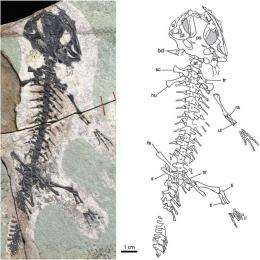March 13, 2012 report
Salamander found in China oldest of its kind

(PhysOrg.com) -- Six salamander specimens were found in an ancient dry lakebed in China recently and now the team of Ke-Qin Gao from Peking University and Neil H. Shubinb of the University of Chicago has identified them as the oldest Salamandroidea specimens ever found. As they write in their paper published in the Proceedings of the National Academy of Sciences, the specimens are believed to be approximately 157 million years old.
The specimens (newly dubbed Beiyanerpeton jianpingensis) were found in Liaoning Province in a place called the Tiaojishan Formation. The team reports that they likely looked very much like salamanders look today with long bodies and tails and short legs. Adults were about four inches long. These particular specimens also sported gills and flattened tails however, suggesting they were swimmers, which would account for their being found where a lake once existed. They also note that generally salamanders have a very unique look to them which makes them easy to identify.
After studying the finds, the research duo suggested that the salamanders likely diverged from others of its kind earlier than had been commonly believed. The early date also puts the salamanders in the Jurassic period, and beats the previous record of the oldest known salamander by 40 million years. A salamander specimen found in Spain dated back to 114 million years ago. This makes B. jianpingensis the oldest know subspecies of Salamandroidea, which are the ancestors of the 557 different species of salamanders that are still around today.
The two describe the specimens as exceptionally well preserved with fully articulated skeletons and with gills that they describe as bony. This, they say was due to their being embedded in volcanic ash which covered the dry lake bed. They also note that several other smaller salamander specimens were found in the same area, but they don’t know yet if they are juveniles, or a different species altogether. They also point out that these new specimens differ markedly from the previous record holder found in Spain, which means that can’t be included in the same family; they are described as much more primitive.
More information: Late Jurassic salamandroid from western Liaoning, China, PNAS, Published online before print March 12, 2012, doi:10.1073/pnas.1009828109
Abstract
A Jurassic salamander, Beiyanerpeton jianpingensis (gen. et sp. nov.), from a recently found site in western Liaoning Province, China is the earliest known record of Salamandroidea. As a Late Jurassic record of the group, it extends the range of the clade by ~40 Ma. The Late Jurassic taxon is neotenic and represented by exceptionally preserved specimens, including fully articulated cranial and postcranial skeletons and bony gill structures close to the cheek region. The fossil beds, consisting of dark-brown volcanic ash shales of the Upper Jurassic Tiaojishan (Lanqi) Formation (Oxfordian), underlie trachyandesite rocks that have yielded a SHRIMP zircon U-Pb date of 157 ± 3 Ma. The fossiliferous beds are substantially older than the Jehol Group, including the Yixian Formation (40Ar/39Ar dates of 122–129 Ma), but slightly younger than the Middle Jurassic Daohugou horizon (40Ar/39Ar date of 164 ± 4 Ma). The early fossil taxon shares with extant salamandroids derived character states, including: separated nasals lacking a midline contact, angular fused to the prearticular in the lower jaw, and double-headed ribs on the presacral vertebrae. In contrast to extant salamandroids, however, the salamander shows a discrete and tooth-bearing palatine, and unequivocally nonpedicellate and monocuspid marginal teeth in large and presumably mature individuals. The finding provides insights into the evolution of key characters of salamanders, and also provides direct evidence supporting the hypothesis that the split between Cryptobranchoidea and Salamandroidea had taken placed before the Late Jurassic Oxfordian time. In this aspect, both paleontological and molecular data now come to agree.
Journal information: Proceedings of the National Academy of Sciences
© 2011 PhysOrg.com



















